When you see a pistol with markings from multiple different manufacturers, it means one of two things: collaborative project, or Chinese workshop manufacture (or Khyber Pass workshop manufacture). Well, this one is definitely Chinese:
Check out all the different markings! We have Brownings (three of ’em!), Mauser, and a Belgian proof stamp all nestled together, like WWI never happened:
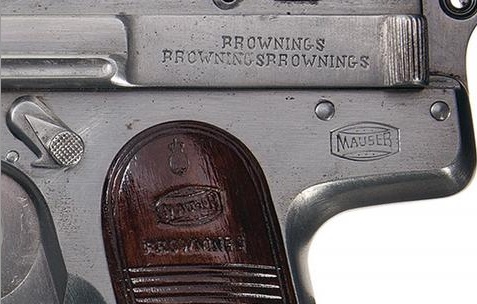
And as it that’s not enough, how about the rear sight leaf?
 Holy pictographs, Batman! I think you need to get one of their secret decoder rings to be able to aim it.
Holy pictographs, Batman! I think you need to get one of their secret decoder rings to be able to aim it.
Okay, joking aside, I find this sort of thing pretty interesting. I only have these three photos (see below for the full size version of the left-hand view), which unfortunately don’t reveal anything about how the design was supposed to function. The pictures were originally taken by Rock Island Auctions for their May 2011 premier auction, and reader James sent them to me (thanks, James!)
The couple of known data point we do have are a 7 inch barrel length and a bore diameter of 7.6mm (aka .30). Considering what was in use in China between the World Wars, that could suggest 7.63mm Mauser, 7.62mm Tokarev, or .32 ACP. Frankly, I kinda doubt the artificer responsible for this pistol was an expert on the pressure and dimensional differences between the 7.63 Mauser and the 7.62 Tokarev, so we might as well consider them the same for purposes of this gun.
We can see from the top view that the barrel ends at the end of the hexagonal section, and using the distance from that to the muzzle with the known 7 inch measurement, I was able to scale the picture to 100% scale. I then overlaid 100% scale 7.62mm and .32ACP cartridges on the grip, and it seems to me pretty clearly that 7.62mm will not fit (note the magazine catch on the heel of the grip, taking up some of the space otherwise available):
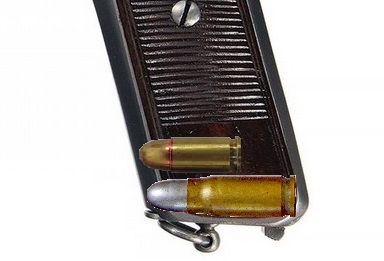
The .32, however, fits just about right. Chinese fighting forces used quite a few pistols in .32 ACP, including copies of Browning with they made with at least 8 inch barrel (source: Bin Shih, “China’s Small Arms of the Second Sino-Japanese War”). While we might consider a long-barreled .32 a counterproductive endeavor, that was not a view necessarily shared by Chinese fighters or gunsmiths of the 1920s and 30s. The magazine capacity is not listed by RIA, but I would guess at 9 rounds plus one in the chamber.
Given the apparently-fixed barrel and relatively weak cartridge, I would further hypothesize that the mechanism is a simply blowback one. That would be simple to make, and perfectly adequate for the design. The hammer is pretty clearly inspired by the C96 Mauser, which is not surprising given their status and popularity at the time. One final guess I would take at the design is that the screw projection at the front of the frame under the barrel probably is the end of the mainspring guide, holding the spring in place so the sling can compress it upon firing.
Other parts, though, still make me think that the builder had never actually tried shooting pistols. Specifically, look at the sights. Even from this basic side view, it looks to me like the front sight an awful lot higher above the bore than the rear sight. To make things worse, the builder seems to have taken artistic license to the ramp under the rear sight, which rises up to the midpoint of the rear leaf, but then drops back down again. Of course, given the sight markings that might not be so much of a hindrance anyway.

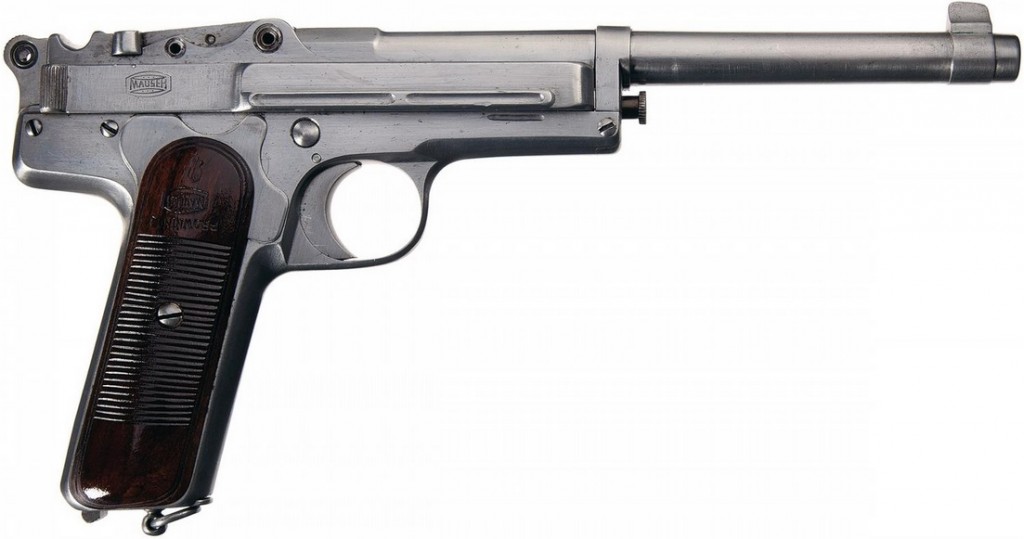
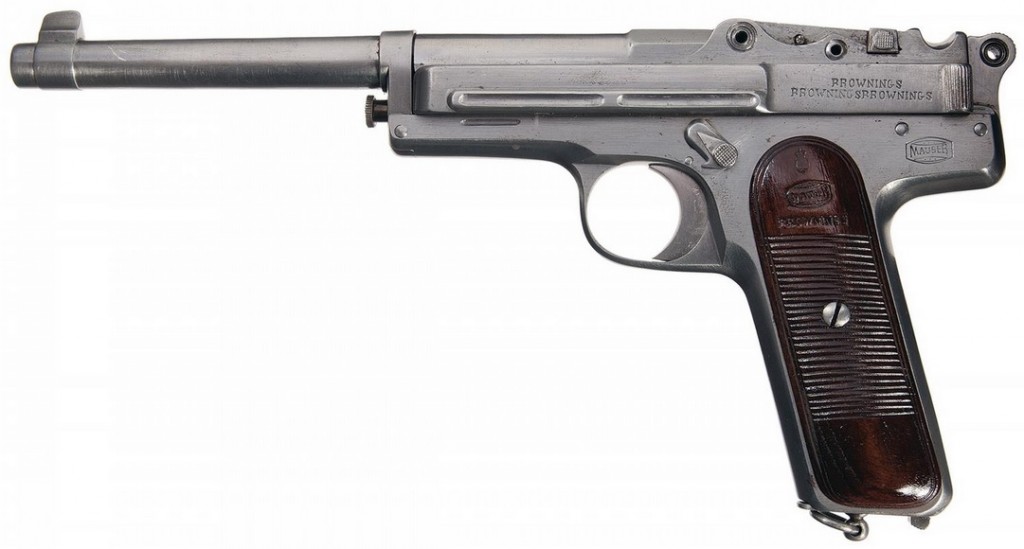
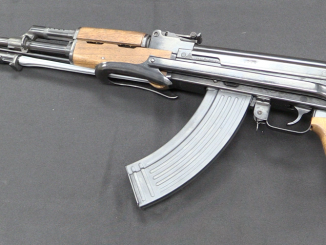


Based on my limited experience with unusual pistols, this is almost certainly Chinese. With the size, there’s a very good chance it’s in .30 Mauser – with a blowback action. The cartridges would be angled in the mag rather than straight, so .30 Mauser should fit. Some of these unusual designs were also cut at the backstrap for a shoulder stock. Regardless of the markings on the tangent sight, it may be a fixed sight (not adjustable) and machined as part of the slide. Note the extractor right in the middle of the sight!
I holding a vest pocket version of this pistol in my hand now. It isa typical blow back type with an open slide like a Beretta with the front barrel band broke off. To field strip it you remove the pin or screw holding the front barrel band to the frame and push the safety/slide stop out and lift the barrel out and the rest slides out from there. The pocket version does not have the phony decorations on top of the slide. It also has FN”s long title stamped on the left side of the slide and Mauser on the right side. The proof markings are all Belgium except one and that is the palm tree. Now the goofy part of the design is that the ejector is two tabs sticking up on the back of the magazine.
What a tressure to think about. Thanks Ian.
Though seeming C96, hammer construction should be borrowed from Webley Scott’s
Field stripping should be carried out by taking out the screw just under the
slide front and bringing the safety lever to a point or taking it out.
Caliber should be .32 ACP since the blow back working.
Front sight should be held low by experiments with heavy at back and long barreled
handguns like revolver in which, firearm held in the hand tends to rise the muzzle
at instant of firing through inertia over the axis of centre of gravity. Though blow
back motion spreads it into time, it seems that big mass joined at back being rather
unsufficient to provide its happening.
Correction; “Front sight; high”.
I call shenanigans on that rear sight. I don’t think it has a rear sight. Look at where the notch is as compared to the ridge right in front of the hammer, it totally blocks the notch in the sight. Couple that with the slide not actually being a slide (it looks like the whole thing is a solid block meant to *look* like an adjustable sight, but is actually not anything of the sort) and the rear sight winds up being just a useless cosmetic feature. “Aiming” (if you can call it that) seems to be done by the front sight alone.
I did notice how low the notch sits relative to the hammer block behind it, but I can’t quite tell if it’s visible or not from the photos available. I have seen Chinese pistols with no rear sights at all, though, so you certainly could be correct.
line tool, though not totally accurate, indicates total obstruction of the rear sight, as referenced by the front sight, by the ridge (and the hammer, but that is less of a problem because the hammer should be down when you are attempting to use the sights.)
But that is not the most interesting part. The “hinge pin” for the “rear sight” (which I am pretty sure is also just a decorative fake) is even more of an obstruction, and you would have to shave off enough metal from the top to allow a real hing pin to simply fall out.
So yeah, rear sight is totally fake.
Wonderful.
And how about other .32 or about pistol rounds of the era present in China? Say, 7.65 mm Luger or 8 mm Nambu? 7.65P was used for the SIG-Bergmann SMGs thousands of which were imported to China in the 1920s (and then a license manufacturing started, but chambered for 7.63), and 8 Nambu was used by the Japs, invading China since 1931. Both are about .30 caliber, bottleneck and midway lengthwise between the .32 ACP (which would be laughingly weak for a HUGE pistol like that) and 7.63 Mauser (which would definitely necessitate some kind of mechanical locking).
The closer I look at the photo’s the more I begin to wonder if this “pistol” even functions at all. I’m having a hard time telling where spent casings are supposed to edject. At first I though that the “rear sight” and it’s base moved back with the slide exposing the breach and extracting a cartridge, but close examinition of the left and right side photo’s makes it look like that whole area is in fact one with the barrel. Also I find it interesting that the piece seems to have a high level of fit and finish as compared to other pistols of the era. Almost certainly this is a one off, hand made, status symbol meant for making an impression at party meetings rather then combat of any sort.
I think it ejects straight up. If you look at the “top” photo you can see how the slide cups around the breach. The fake leaf sight pin is right about where the breach face is, nestled into the fancy, yet fake, rear sight.
Well, it’s obvious. It’s a Brouser. With a bit of Schwarzlose or Mannlicher out of wedlock.
I guess that makes it a Brouschwarmlicher.
While a gun made up of so many parts taken from different sources for any variety of reasons is interesting, esoteric and perhaps the cause of much head-shaking by our standards, it should still be kept in mind that it is, like any other mechanical device, the sum of its parts. What is most important is if that sum functions well and functions reliably, not whether it is a mongrel or a bastardized offspring of some gunsmith’s imagination.
We should also take into account the circumstances that gave rise to such a creation, eg., desperate shortage of whole weapons, parts and available ammunition ; vigilant suppression by an occupying force ; and lack of an integrated and organized resistance with adequate support.
You work with what you have on hand and make the best of it as you know how.
I have NO IDEA what the hell it is, but I WANT ONE!!!
It is so clear that the rear sight is purely non
functional and ornamental. In fact, analyzing such
a pistol using such a powerfull round like 7.63
Mauser without locking device, or a weak round like
.32 ACP ın an enarmous construction, through
technical standarts, would be ironic enough. But, buıldıng a non functional part with an effort nearly
being sufficient to make the real thing is also
questionable.
Different minds, different kinds.
It reminds me of this SMG most likely in the same calibre.
http://www.thefirearmblog.com/blog/2012/07/26/interesting-chinese-submachine-gun/
That SMG is a modified Thompson in 7.62×25, FWIW.
was it “restored” at any time to your knowledge or has i just been that well preserved. I say this becuase it seems exstreamly clean for a 70+ year old shop pistol thats somhow crossed the ocean
kinda reminds me of this form a proportional standpoint http://3.bp.blogspot.com/_G2xmVJU3PyM/TSUI8pQZjpI/AAAAAAAAAdY/nc0Yv_tmqak/s1600/KimbalArms_ARfeb1956.JPG
According to Rock Island Auction in a lot for one of these exact Kimballs:
“One of less than 250 produced circa 1955-1958, the Kimball was a failed attempt at producing a blowback pistol in 30 Carbine, using a series of cut rings in the chamber. In theory, on ignition the casing would swell to fill these rings, delaying extraction long enough for pressure to drop. Of those manufactured, many were destroyed during use by the severe recoil, making examples in this fine of condition even rarer. Blade front and adjustable rear sights, with the Detroit address on the left side of the chamber, serial number on the right, and finely checkered grips. In a hardwood case, French-cut to fit the pistol.”
I guess it wasn’t very successful!
http://www.rockislandauction.com/viewitem/aid/55/lid/816
Kimballs were chambered for .30 carbine and .22 hornet
Think of them as an early and unsuccessful attempt to do what the FN 5.7 pistol does.
Kimball had attempted to sell them to the US air force as pilot survival guns.
The design is blow back, with the barrel allowed to recoil a short distance with the slide (I think the .38 spcl chambered blowback 1911s had that feature too).
the breeching and blowback part of the gun seems to have worked without giving any KBs that I’ve read about.
What appeared to go wrong (very quickly – like 100 rounds or less) was the pin which took the impact of the Hi Standard style slide, peened and broke, letting the slide fly off the back of the pistol.
There’s a lot to be said in favour of JMB’s later enclosed slides which can’t come off the back. Those who ignore them (eg Walther and Beretta) risk having flying slides.
If you buy the gun, please share some photos
I did my reading up on the Kimball before I discovered Espacenet, and wasted hours unsuccessfully looking for the floating barrel patent.
Here it is:
http://worldwide.espacenet.com/publicationDetails/originalDocument?CC=US&NR=2846926A&KC=A&FT=D&ND=3&date=19580812&DB=EPODOC&locale=en_EP
I believe that something similar was done with the original run of Tanfoglio .40 S&W pistols based on the CZ75.
A friend had a couple of them. The first was amazingly unreliable. I wouldn’t hesitate to leave one with a loaded magazine and an empty chamber around small children, since they probably couldn’t chamber a round successfully, even if they had the strength to cycle the action. Rounds regularly hung up entering the chamber. When I looked in the chamber, I saw why: There were a series of fine annular rings seemingly machined into the surface of the chamber. It looked like the OUTSIDE of the barrel of an SKS. I’d read that the early guns displayed signs of early unlocking, and assumed that the rings were used to create friction to retard ejection of the spent case to allow the bullet to exit the muzzle before the fired case was ejected.
In any case, the first copy was totally unreliable, with maybe two consecutive shots to its name without an ftf. He sent it back. The replacement was marginally better, with something like a record of three consecutive rounds without an ftf. He finally threw in the towel, sent that one back and bought a Glock 22, which he’s had for something like twenty years.
Too bad about the Tanfoglio copy of the CZ-75, which is itself easily one of the most reliable and best-made pistols in the world.
There are drawings of two very similar pistols in A.B.Zhuk’s “Pistols and Revolvers” book* (in Russian). No details other then he notes that it is construction inspired by Mauser C-96.
Book is a gold mine for obscure designs, so far there were only few designs that were not in it.
*I actually have both original and local edition, by A.B.Zhuk and Milos Vasic, which is somewhat expanded compared to original.
I have a first edition English copy, and it is indeed a gold mine. The second edition omitted some of the best information in the book, including most of the pinfire stuff. I got mine FREE from an old guy at our club who just left a bunch of books, fired cases, and whatnot on a table for anyone who wanted them.
Hey Ian,
I’ll be sure to forward you some more unusual stuff as I come across them on my voyages on the Interwebs and real life!
James
Sounds good to me!
From the looks of the receiver, I’d say we’re looking at a straight-blowback based on the Mauser M1910/34 design. The only major difference being the W&S-type outside hammer. If it is a Mauser “semi-clone”, that would handily explain the Mauser banners on both the left rear of the frame and the top of the left grip panel.
Caliber is almost certainly .32 ACP/7.65 Browning, as the M1910/34 magazine and feed system holds the cartridges almost perfectly horizontal relative to the boreline.
Keep in mind that at that time, .32 was considered a perfectly adequate caliber for a military officer’s sidearm (which he would be using to “wave” more than he would actually fire it), or a police weapon. The C/96-type rear sight (whether it actually works or not)tends to indicate the former employment as the one intended.
Incidentally, that peculiar “hump” in the rear-sight ramps could indicate that it was copied, not from the C/96, but from a Mauser bolt-action rifle like the original Gew 98 “Lange”. The earlier models had a volley-fire type rear sight with such a humped ramp, IIRC.
cheers
eon
Despite its questionable utility, I really like the look of this pistol. I think it is pretty attractive and might point well, though that probably won’t help much with the poor (or non-existant) rear sights.
It looks like it was cobbled together from left over parts and marked with Names proof marks familiar to the Chinese market. It was a fact that Buddhist philosophy held all weapons to be bad luck. An uneducated buyer would take anything that shoots. Like Pakistan today. That is a wicked looking pistol but a broomhandle or copy there of would have been first choice. BTW 32 ACP was very common and popular in China until the Reds standardized along Soviet line.
Nice peace.dIt is a copy of the russian construktor Margolins desin and will deffetnely be in 7,62 mm Tokarev, in the book by Bolotin, 5 centuris of russian gunmaking, has a picture of it. the hight of the sigths, depend on the distance, the weapon was intended to be used.It is a kocked desin, with the Bergmann locking block, also used in the Lathi pistol
The submashingun adopted by the chineese , was a Bergmann-Pieper in 7,63 Mauser. The qalety, was eqal to SIGs, but not made by thrm
Peter
If it weren’t for the age I’d think “movie prop.”
When the picture first came up, my first thought was “Gabbett-Fairfax Mars”, except this thing looks like a slimmed-down, second-generation Mars.
I like it!
It looks like the slide is a U shape, open at the back. I’d guess you’d unscrew the knurled knob at the front and rotate the barrel support out of the way, then pull the slide off the front.
The recoil spring would be trapped between the U-shaped slide and the barrel mount. If the knob had a long bolt on the end, it could double as a spring guide rod.
The octagon part of the barrel may be part of the frame, with the round part screwed into the front.
Sighting along the magazine well, either the cartridge is *very* short, or the breech is relieved/ramped underneath to feed.
The lever on the left appears to be a slide lock. There’s probably room for safety linkage running rearward. No idea as to why it is swung down so low, unless maybe the gun was improperly reassembled some time along the way.
The sight… it *looks* like a standard rifle design, except it doesn’t appear to have been built that way. Hmm.
I like the proof mark on the grip. Can never have enough proof marks.
Regarding the type of locking mechanism (or absence thereof), if nobody actually was able to cycle the action, you don’t know for sure how it’s really constructed or works.
Some blowback guns use a heavy hammer spring to supplement slide/bolt inertia. Combined with a recoil spring like a suspension spring on a Sherman tank, that MIGHT provide JUST enough delay to allow the gun to “safely” fire the 7.63mm Mauser cartridge… for a while.
Interesting observation. In this case, what happens after “awhile”?
Such an action would in all likelihood be marginal at best. As the springs started to deteriorate with normal use, their retarding effects would decline over time, and the action would start opening sooner and sooner until it opened with sufficiently high residual pressure to blow out a case and damage the action… and the shooter.
There are a FEW “successful” high pressure blowbacks, like the Astra M600. Whether this could have been one of them hinges upon just how it really works, and the quality of the materials and workmanship.
Thanks for the reply, Chris — your explanation is much appreciated. Incidentally, for anyone interested in collecting Astra pistols, there are several currently available at http://www.simpsonltd.com, including an M600/43 in 9mm Parabellum in excellent condition with all-matching serial numbers ( except for the magazine ). There is also an original leather holster designed specifically for the M600 in almost mint condition, but with a different serial number.
I had a minor fascination with the Astra M400/600 series when I was in grammar school in the 1960s, since they were the “foreign gun” du jour on “Mission Impossible” most weeks. Also, before and for a while after the Gun Control Act of 1968, they were widely and cheaply available for sale (including through the mail). They and “Unique” and “Ruby” type .32acp blowbacks were a fixture in the ads in the front and back of “Guns & Ammo” and other magazines.
How times have changed! 🙂
BTW, there is a second 9mm M600/43 available at http://www.simpsonltd.com, also in excellent condition, except that this one comes complete with the matching holster ( with AKAH logo ) and spare magazine. It also has Nazi proof markings ( WaAD20 ) on the right side of the frame behind the grip panel. All major parts appear to have an abundance of proof markings, both the original Spanish ones as well as overstamps such as PIT.PATR.08 over the Spanish proof on the chamber.
Regarding the rear sight:
I’ll bet it actually does adjust for range. The “pin” probably has some other function. I’d bet that the trunnions on the sight leaf are held in place by spring pressure, as I seem to recall them being on a lot of tangent leaf rifle sights.
The very low position is probably a “stowed” position that allows it to be kept in a holster without it catching on anything. If I had to bet, I’d venture that most warlord or KMT officers weren’t planning on competing against Charles Askins at Camp Perry. You don’t really need the rear sight to shoot a bound prisoner in the back of the neck…
no, the high res of the top photo shows clearly that the “sight leaf” is engraved into the slide and does not articulate. The whole rear sight is just a cosmetic feature, nothing more.
Surprisingly realistic look, most probably is obtained by making the breechblock
a separate piece and pinning it between the side walls formed at top of slide
where a real adjustable sight to be mounted. The front pin and rear pins are
for retaining the seperate single piece breechblolt with engraved fake distance
slide and the middle one is for retaining the extractor. The outer heads of both
large pins are also engraved and not functional. Real pins are mounted deep. Dan 91’s
sample has only front retainer pin.
Here’s another copy of the design for sale. It’s in .32acp.
http://www.collectorsfirearms.com/chinese-semi-auto-pistol-32-auto-pr23862/
Looks like its sibling.
We are in possession of one of these Chinese fakes. Ours has a 5 3/4″ barrel. It is definitely .32 Auto cal. (7.65x17mm SR or 7.65mm Browning). It is a blowback action. Ours has a bulged barrel. It does function/cycle. I looks almost exactly like theone that Collectors has for sale. The C96 type sight is not functional, its just for show. Looking from the rear through the rear sight the view of the front sight is blocked by the fake C96 sight.
http://www.aubruin.com/photos/AA%20Auctions/Roth%20Chinese%20Fake%20Mauser/01.JPG
http://www.aubruin.com/photos/AA%20Auctions/Roth%20Chinese%20Fake%20Mauser/07.JPG
http://www.aubruin.com/photos/AA%20Auctions/Roth%20Chinese%20Fake%20Mauser/18.JPG
http://www.aubruin.com/photos/AA%20Auctions/Roth%20Chinese%20Fake%20Mauser/21.JPG
See all the photos of the Chinese/Pashtun Mauser/FN fake at: http://www.gunauction.com auction # 12403097
Where would it eject? The rear sight is in the way for a top eject, and there doesn’t appear to be room for ejection on the sides. It does, however, look very much like it could be a Allin “trap-door” action. That would explain the apparently non-functional rear sight–it’s not a sight, it’s the bolt. The bar down the middle of the “sight” would be the extractor, and it would be chambered in 7.62 Mauser or the like.